ENVIROforensics is an environmental engineering firm specializing in environmental services, legal support and turning environmental liabilities into assets.
Don't wanna be here? Send us removal request.
Photo

"We wish you and your loved ones peace and prosperity this holiday season and may God watch over our servicemen and servicewomen over seas." -Enviroforensics' Pres. & CEO, Stephen Henshaw on behalf of all at Enviroforensics. #enviroforensics #happyholidays #happynewyear
0 notes
Photo
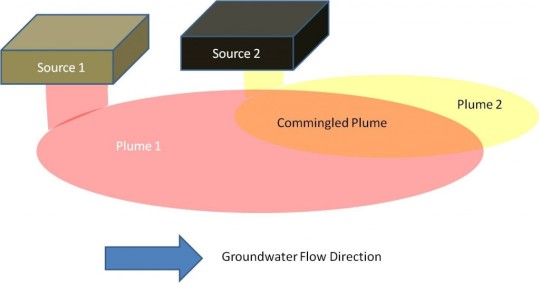
Enviroforensics’ President & CEO, Stephen Henshaw talks commingled plumes. When contaminated groundwater plumes run together, who is responsible for the clean up?
A commingled plume is the term used when two or more plumes of contaminated groundwater blend together. The blending or commingling of groundwater plumes is a fairly common occurrence in urban or commercial settings. A very common illustration of commingled plumes is when the groundwater beneath two corner gas stations is contaminated with releases from the underground storage tanks. The groundwater may all move in the same general direction, but because the plumes spread or fan out as they migrate, the plumes blend together and overlap one another.
For the full article visit: http://enviroforensics.com/commingled-plumes-who-is-responsible-for-the-cleanup/
#commingled plumes#contamination#environmental#environment#groundwater#cleanup#cosultants#engineers#infographic#infograph
2 notes
·
View notes
Photo

Let’s give it up for Chris Jaros, P.E.! Mr. Jaros recently passed the Indiana Professional Engineer examination. Congratulations Chris! #enviroforensics #environmental #engineer #environment
0 notes
Photo

Vapor intrusion is one of today’s most regulated fields requiring assessment and mitigation to relieve your environmental liability. We resolve complex environmental issues involving banks, lenders, buyers, sellers, regulatory agencies, lawyers, and municipalities with our business owner strategies and solutions. Our experience, talented team made of engineers and scientists are the experts on helping restore property values through sensible and fair assessments and clean up. We’re the expert resource on vapor air intrusion: http://enviroforensics.com/vapor-intrusion-assessments-can-you-trust-your-indoor-air-data/#more-1639 (Photo: Our Enviroforensics VI experts, Jeff Carnahan, VP & Director of Technical Services and Jesse Wright, Sr. Engineer & Manager of Remediation Operation and Maintenance) #enviroforensics #enviro #environmental #environment #vapor #intrusion #vi #vocs #volatileorganiccompounds #contamination
#vocs#intrusion#vi#volatileorganiccompounds#environment#environmental#contamination#enviro#vapor#enviroforensics#more
0 notes
Photo
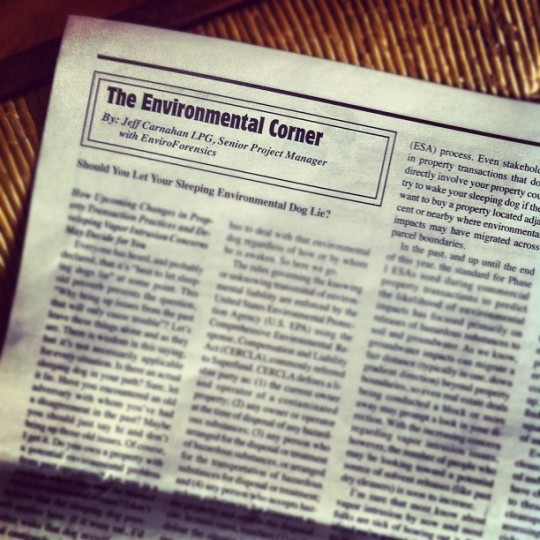
Turn to page 18 in this month’s issue of Cleaner & Launderer for our Vice President and Director of Technical Services, Jeff Carnahan’s, newest article on Vapor Intrusion. Jeff discusses how upcoming changes in property transaction practices and developing vapor intrusion concerns influence your stance on whether to let your property’s sleeping environmental dog lie. Read the digital edition, online at: http://digital.turn-page.com/i/96614Learn more about our vapor intrusion from our VI expert Jeff Carnahan, at: http://enviroforensics.com/about/key-personnel/jeff-carnahan/ #enviroforensics #environmental #vaporintrusion #vapr #intrusion #environmental #contamination #breathing #air #environment #issues #enviroconcerns #vi #vocs #voc #theenvironmentalcorner #cleanersandlaunderers
#theenvironmentalcorner#vaporintrusion#enviroconcerns#intrusion#voc#vi#cleanersandlaunderers#air#environment#environmental#breathing#contamination#vocs#enviroforensics#vapr#issues
0 notes
Photo

Enviroforensics’ Project Manager, Darci Cummings informs us on how the revisions on the standard by which Phase I Environmental Site Assessments (ESAs) are performed, which is currently under review by the US EPA, have significant proposed modifications that are expected to have a considerable impact on the environmental due diligence process as we know it. Read the full article, “Here Comes the Next Game Changer; Phase 1 Environmental Site Assessments” at: http://enviroforensics.com/here-comes-the-next-game-changer-phase-i-environmental-site-assessments/ #ESA #US #EPA #enviro #enviroforensics #environment #environmentalscience #environmentalservices #environmentalsiteassessment #phase1
#phase1#environmentalsiteassessment#us#environment#environmentalservices#esa#enviro#enviroforensics#environmentalscience#epa
0 notes
Photo

Happy Birthday Steve Henshaw! This is Steve, Enviroforensics' President & CEO, with a village leader in Bankoni, Mali earlier this fall. #hbd #enviroforensics #enviro #mali
0 notes
Photo

Please show your love and support this holiday season! Join us in the last week of our Annual Toy Drive benefiting the families facing homelessness in Indianapolis right now. #monumentcircle #indy #holiday #toydrive #indian #ind #indpls #indianapolis #circlecity
1 note
·
View note
Photo

Our 2nd Annual Toy Drive Toy Drive has commenced! In partnership with RTV6 Toy Drive presented by AAA Insurance, Enviroforensics is collecting new, unwrapped toys for newborns through children twelve years of age. We are collecting toy donations now until December 10. For more information, visit: http://www.theindychannel.com/about/rtv6-toy-drive-how-to-donate or visit our Facebook page for more donation locations. #Holiday #toydrive #RTV6 #AAA #hoosiers #goodwill #kids #babies #indiana #indianapolis #indy #helpkids #enviroforensics #enviro
#toydrive#rtv6#kids#aaa#hoosiers#goodwill#indy#indianapolis#babies#enviro#indiana#holiday#enviroforensics#helpkids
0 notes
Photo
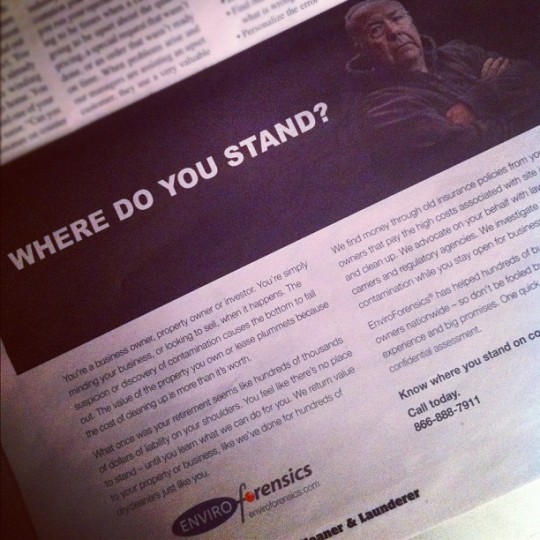
Environmental law is an unique blend of science, regulation, and statute. Find us in November's Cleaner & Launderer. #enviroforensics #enviro #environmental #services #epa #insurancearchaeologists #riskmanagers #litigationsupport #insurancearcheology #expertwitness #subsurface #contaminants #humanhealth #ecologicalrisk #environmental #cleanup #legal #strategy
#subsurface#ecologicalrisk#insurancearcheology#insurancearchaeologists#legal#strategy#environmental#humanhealth#cleanup#expertwitness#contaminants#services#enviro#enviroforensics#riskmanagers#litigationsupport#epa
0 notes
Photo

It always amazing to see what nature and the environment can make together. This photo is of a natural wood bowl in our office.
0 notes
Photo

Another addition to our Enviroforensics Art Collection. A beautiful southwest painting. #enviroforensics #southwest #art #collection #mountains (Taken with Instagram)
0 notes
Photo

We've added to our art collection at Enviroforensics! This beautiful landscape reminds us of the view from our Northern California office. #enviroforensics #enviro #landscape #painting #art #collection #indy #downtown #indianapolis #indiana #crossroadsofamerica #midwest #capitol #street (Taken with Instagram)
#indianapolis#art#capitol#painting#indy#collection#midwest#downtown#street#indiana#enviro#enviroforensics#crossroadsofamerica#landscape
0 notes
Photo

Nationally recognized experts in vapor intrusion. #enviro #vaporintrusion #toxicgas #vocs #voc #vi #environmental #contamination #toxic (Taken with Instagram)
0 notes
Text
Green Mean$ Green
Can you afford not to go green?
Written by Steve Henshaw, President and CEO of EnviroForensics in collaboration with John Soderberg, PE, Esq. As seen in the September 2012 issue of the Cleaner and Launderer.
Nowadays everyone in business wants to be considered environmentally “friendly” or “green.” The retail dry cleaning industry is no exception. In fact, given the ecological concern over perchloroethylene or “PERC”, actual or perceived, the retail dry cleaning trade has been at the forefront of the green movement. However, there is another aspect of an environmentally friendly operation that most cleaners do not recognize, namely, that reducing consumption reduces costs.
The primary reason the trade participates in environmental conservation is because it is part of being a good corporate citizen. Hence, most retail cleaners are only remotely aware of the potentially positive economic impact “going green” may have, independent of its positive public relations impact. The purpose of this article is to explore that aspect as well as provide a simple method of prioritizing potentially available “environmentally friendly” or “going green” activities.
Going Green
At the outset, it is necessary to first define the term “going green.” To “go green” means to reduce, either directly or indirectly, the amount of energy and other environmental resources consumed. An important aspect of this reduction effort is often described as reducing the “carbon footprint.” The term “carbon footprint” refers to the amount of carbon dioxide (CO2) we emit individually in any given period.
CO2 is produced from many sources and is one of the primary gases responsible for global warming. In fact, it is a major component of what we exhale every time we exhale! It is produced in much greater quantities by burning, coal, oil, or gas to propel a car or truck, produce electricity, or produce heat and hot water. It is an integral, albeit often overlooked, part of our everyday lives. The mitigation of carbon footprints through solar, wind energy, or less fuel usage by utilizing more efficient fuel combustion or better insulation is one way of reducing a carbon footprint and is often known as carbon offsetting.
One can “go green” indirectly and directly. It can be done indirectly by purchasing recycled products and recycling in general. The less new materials used, the less energy required to produce them and the less carbon-based fuel consumed. It is done directly, by consuming less water and employing more efficient energy consumption devices.
As an individual consumer, whether by lowering your thermostat or unplugging seldom-used appliances, chances are you have already scaled scale back on energy use. You are probably also one of the many consumers who have Energy Star-qualifying products. Last year, one in three people reported using the label as part of a purchase decision. According to the Department of Energy, if you bought an Energy Star-qualified commercial dishwasher, you saved an estimated $200 per year. Those who took home an Energy Star refrigerator can look forward to a 15% less expensive monthly electricity bill. Isn’t it high time you evaluate whether or not, as a business, you should be doing this as well.
The Profit Aspect of Going Green
Profit equals total income less total cost. Hence, there are two basic ways to increase profits. First, is to increase prices and the second is to reduce costs.
This latter aspect is where “Green meet$ Green”. Obviously, the more efficient a gas or oil burner, the better insulated a building and the less water used, all relate to lower utility bills. The lower the bills, the lower the costs and the higher profits become.
First, there are no-cost steps one may take immediately to reduce resource consumption. Purchasing new lavatory facilities solely to reduce water consumption may not be a cost-effective step. However, simply putting a brick in the toilet tank to reduce annual water usage is an easy, highly effective, and uncomplicated step that can result in a significantly lower water bills. Similarly, posting a “don’t forget to turn off the lights” sticker conspicuously above light switches can also have a significant impact at virtually no effort or expense. Some of you probably remember that during the Carter Administration we were inundated with public service announcements to turn down our thermostats during the winter, to wear a sweater and to turn off the lights. Today, we have to constantly remind our kids to do just that.
There are also other, relatively inexpensive steps such as using recyclable hangers and poly bags, and reusable garment and laundry bags, that can go a long way toward not only carbon footprint reduction but also in increasing profit both directly as well by producing a more positive public perception. Another often over looked and cost-free option is the no-cost energy assessments offered by many local gas and/or electric utility companies.
Next, is the “simple payback” concept. This comes into play when the need to replace a piece of equipment arises. Often two or more replacement choices are available. One choice is classically less expensive than the other. However, the more costly option is often more energy efficient. When deciding which option to choose you will be aided in many instances by the Energy Efficiency Ratio or EER for electrical appliances. If such companies are not offering you a choice, it may be because they are trying to get rid of their stock of old, less energy efficient equipment.
For example, an air conditioner has an energy efficiency rating that lists how many BTU’s per hour are used for each Watt of power it draws. For room air conditioners, this rating is the Energy Efficiency Ratio, or EER. These ratings are posted on an Energy Guide Label, which must be attached on a visible place on all new air conditioners.
Once you ascertain your average electrical usage cost in dollars per kilowatt, which is readily available from your electric bill (or, if not, by simply calling and asking your local utility) a payback comparison between two comparable appliances such as air conditioners you are ready to begin. First estimate the number of hours you plan to use the air conditioner over the year. By multiplying the hours of usage per year by the air conditioner’s BTU per hour rating on its face plate you will obtain the BTU per year required to run the unit.
Next, divide the BTU per year by the EER, and multiply that by the electrical cost per watt. Dividing this by 1,000 provides the cost per kilowatt. This figure is the yearly cost to operate the unit. Dividing each of the two unit costs by their respective annual energy costs, yields their respective paybacks.
This procedure can be used to not only select between two or more similar products, but also to prioritize replacement of different initiatives. For example, let us compare the need for new insulation with that for a new water heater. Both are deemed necessary but not immediately so. The task is to choose the more cost effective action first.
Assume that the insulation will require a total capital outlay of $5,000 and, after application will result in a $500 a year energy bill. It has a payback of $5,000 / $500 per year. Put another way, the improvement will pay for itself in 10 years at the current utility rate. In contrast, a new water heater will cost $2,400 and result in a $120 energy costs. This results in a payback of $2,400 / $120 per year, a payback of 20 years. Clearly, the insulation replacement should be accomplished first if at all possible.
Summary and Conclusions
Obviously, in these economic times being green is desirable from a customer relations standpoint. However, it can also mean a more profitable operation by reducing costs. The key to successful economic “green” is payback. The shorter the payback period is the better choice. Utilizing simple arithmetic, the guesswork can be eliminated from the decision of what to purchase first.
We have experience and knowledge to assist you in your green evaluations. Please feel to contact us for help.
1 Mr. Soderberg is both an environmental attorney and environmental engineer with over 36 years experience in the environmental field. Mr. Soderberg represents corporations, businesses and individuals before federal, state and local environmental regulatory agencies, as well as federal and state courts. He is a committee member of the nationally-based Green Cleaners Council.
With 30+ years of experience, Mr. Henshaw holds professional geology registrations in numerous states. As President and CEO of EnviroForensics, Mr. Henshaw serves as a client and technical manager on projects associated with site characterization, remedial design, remedial implementation and operation, litigation support and insurance coverage matters. He has acted as Project Manager or Client Manager on several hundred projects, involving dry cleaners, manufacturers, landfills, refineries, foundries, metal plating shops, food processors, wood treating facilities, chemical blenders, and transportation facilities.
Mr. Henshaw has built a leading edge environmental engineering company that specializes in finding the funding to pay for environmental liabilities. By combining responsible party searches with insurance archeology investigations, EnviroForensics has been successful at remediating and closing sites for property owners and small business owners across the country, with minimal capital outlay from clients.
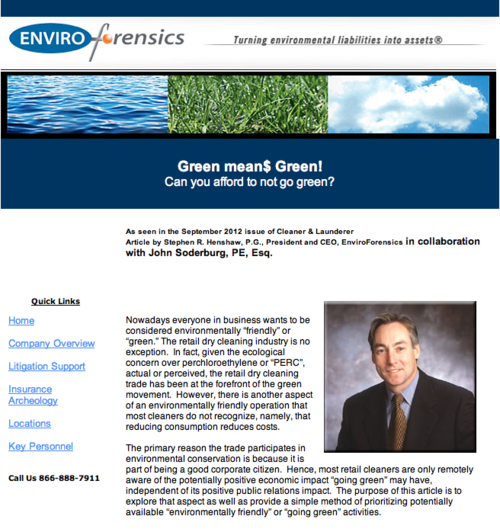
He is a regular contributing writer for several dry cleaning trade publications on environmental and regulatory issues and remains active with dry cleaning associations by providing insight on changes in law and policy
#enviroforensics#enviro#chemical contamination#going green#green#environment#drycleaners#remediation#steve henshaw#SRH#John Soderberg#cleaner & landerer#geology registrations#remedial design#Green Cleaners Council#solar energy#wind energy#Department of Energy#reen meet$ Green#environmental attorney#environmental engineer#environmental engineering company#finding the funding to pay for environmental liabilities#environmental and regulatory issues
4 notes
·
View notes
Photo
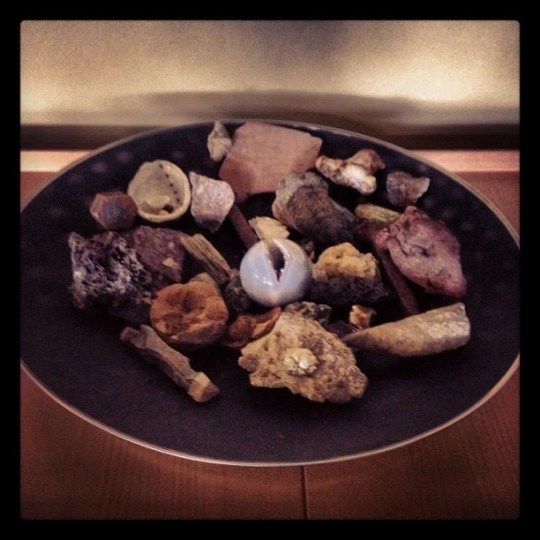
Some of our rock collection at our environmental engineering firm! #geology #enviro #environmentalservices (Taken with Instagram)
1 note
·
View note
Text
Can Perc Releases Be Age Dated and Fingerprinted?
For years parties responsible for the costs associated with environmental investigations and cleanups of Perc contamination have been trying to determine when Perc releases have occurred. This topic has important ramifications when sites have had a series of dry cleaning operations over time, when different insurance carriers insured dry cleaners and property owners, and when several dry cleaning releases have comingled together from different dry cleaning locations.
So, for the past 15 to 20 years, scientists like Dr. Konrad Banaszak with EnviroForensics, have been trying to figure out how to age date PERC releases. So, can Perc releases be accurately age dated? The answer is yes, no and maybe.
One of the ways to determine a relative age of a release is by evaluating the breakdown products of Perc (trichloroethene, dichloroethene, and vinyl chloride). Generally speaking, groundwater that contains higher concentrations of vinyl chloride is typically associated with an older release of Perc. However, there are limitations in that the ambient water quality has a direct effect on the breakdown time. For example, Perc generally breaks down more rapidly in an anerobic groundwater environment, one that is starved for oxygen. Conversely, Perc released into an aerobic groundwater environment would generally break down very slowly. Therefore, using the ratio of breakdown products to Perc is not singularly a reliable method for estimating the age of the Perc release.
Another approach is to determine the horizontal extent of the contaminated groundwater plume. In general, the groundwater velocity multiplied by time equals the distance traveled (R*T=D). Hydrogeologists can determine the groundwater velocity and the distance the impacted groundwater has migrated from the source area and may be able to provide a release time. Additional information is required to more accurately determine the time of travel in that the higher the organic content of the aquifer, the more the volatile organics like Perc are retarded or slowed from migration.
The above scenarios can be difficult to provide accurate estimates, although hydrogeologists and scientists can develop reasonable estimates. A more complicated scenario is when one is trying to determine the age of a Perc release when it has commingled with another release. Scenarios include different releases at the same location over different times periods or different releases from different dry cleaning establishments. The later is common in large regional contamination studies.
In situations where commingled plumes exist, scientists more likely than not would rely on evaluating different isotopes of Perc. To understand this approach, the scientist must have information on the original product that the dry cleaner used over specific time periods. Different manufacturers of Perc had unique product formulas from their competitors and recycled Perc would have a very different formula from virgin Perc. Therefore, different isotopes become the focus of the study.
Isotopes may be an idea that you have long forgotten. The idea of isotopes is simple enough in that different atoms of the same element can have different masses. There is an entire field called isotopic geochronology that focuses on age dating rocks, fossils, even cloth, such as shrouds found in ancient tombs. A common technique for age dating younger objects (younger than about 60,000 years old) use carbon. Carbon has an isotope, atomic mass 14 or carbon 14 that is radioactive and decays.
To illustrate this in age dating a perc release the following is assumed; a Perc molecule has two carbon atoms and four chlorine atoms. There are 5 different molecules of perc by mass. The two carbons have a mass of 24. Carbon practically speaking has only one isotope, but chlorine has two common isotopes (35 and 37). The resulting Perc molecule may weigh 164 (all four chlorines being 35), 166, 168, 170, or 172 (all four chlorines being 37) units.
By quantifying the various molecules of Perc in groundwater samples, we can in some cases distinguish Perc by its source. This may be useful in establishing which sources contributed how much contamination to a plume that is composed of several sources. It may also be useful in age dating a Perc release.
In the case of a commingled plume, the isotopic “fingerprint” of each source needs to be established. In theory this is not too difficult and would require just a couple of samples in the source area and at the leading edge of the plume. However, age dating a plume is more complex. A precondition is that we know the isotopic fingerprint of the Perc product that was used at a given time and location versus the isotopic fingerprint of the Perc product used at a later time and location. If one is trying to establish the age of a release at the same site, we need to know the date when the Perc products that were used switched from one to another. If that information can be substantiated, we may be able to differentiate the isotopic fingerprint near the source area from that at the leading edge of the plume. Further work would then be required to discover where the change occurs within the plume. By coupling an understanding of groundwater flow velocity and of the change in the isotopic signature in the plume, one could probably determine the age of the release.
The cost to evaluate the isotopic signature of the Perc in groundwater samples is relatively inexpensive, approximately $350 per sample. Obtaining the soil or groundwater samples, conducting the investigative research to determine what Perc products were used would be additional.
Written by Stephen Henshaw, P.G., President and CEO, EnviroForensics As seen in the May 2010 issue of Cleaner & Launderer
#steve henshaw#enviroforensics#enviro#environmental#environmental services#drycleaner#drycleaners#dry cleaner#dry cleaners#perc#western cleaner & launderer
0 notes